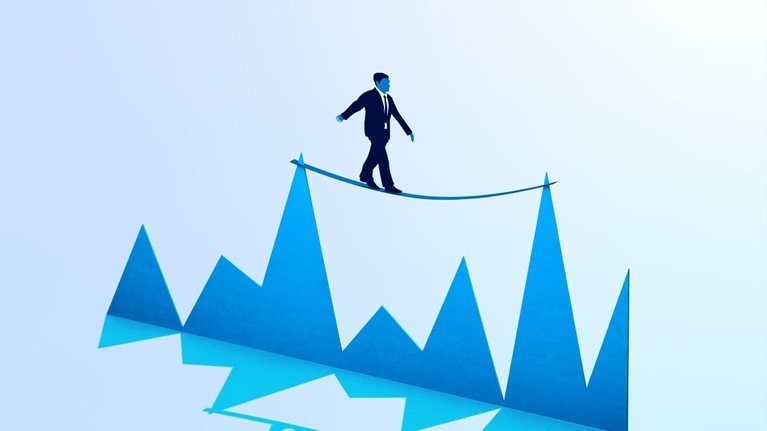In this episode of the Inside the Strategy Room podcast, three authors of a recent article on the economic outlook for 2023 and beyond discuss how businesses can prepare for what may be a challenging couple of years. Michael Birshan is the global co-leader of McKinsey’s Strategy & Corporate Finance Practice and serves on the McKinsey Global Institute Council. Ezra Greenberg leads our work on macroeconomic scenarios and trends globally and is co-leader of strategic transformation services in North America. Ida Kristensen is global co-leader of the Risk & Resilience Practice. This is an edited transcript of the discussion. For more conversations on the strategy issues that matter, follow the series on your preferred podcast platform.
Sean Brown: The economic outlook is always a key business consideration. What makes it particularly important now?
Michael Birshan: It’s an unusual period of volatility. We have new shocks layered on top of old shocks layered on top of longer-term disruptive trends. Inflation and low consumer confidence, for example, are layered on top of some overhangs from COVID-19 as well as trends like digital disruption and the sustainability imperative that we’ve been wrestling with for years. In times of volatility, an insights edge is valuable because if no one knows what’s going to happen, being 10 percent more right 10 percent more often can be a real advantage. So my colleagues and I asked, what might happen next?
Ida Kristensen: At an event I recently attended, there was a debate about whether 2023 would be a year like no other. I’m having those types of conversations with many of my clients. We are living in a world where the known unknowns are increasing and we can no longer say, “Let’s see what happens and then we will react.”
Sean Brown: What are the biggest macroeconomic headwinds companies face?
Ezra Greenberg: Inflation has peaked in the US and likely in Europe, although there is continuing uncertainty there about energy prices. That doesn’t mean we are at a good level, but we have turned a corner in terms of inflation acceleration. When we look at wages in the US and the UK, however, they have been increasing at two to three times the rate that we saw before the COVID-19 pandemic. The reason for that is clear: in the US, 21 million people lost their jobs between March and April of 2020, which created an enormous shock to the labor market, and we are still dealing with the repercussions. I like to say that the labor market is a supply chain with feelings—it’s not going to just bounce back. The UK and continental Europe received a smaller initial shock but are likely to see wage pressure later in 2023 and in 2024.
There is some disagreement about how we got to where we are. Many articles attribute the unexpectedly high inflation to money printing and government subsidies. It’s more nuanced than that. The first reason is the direct impact of commodity prices and supply chain disruptions on consumer prices. Those impacts hit businesses as well, which then pass those price increases along as best they can to protect their margins. Those two factors account for roughly two-thirds of the inflation increase. The remaining third is a combination of monetary policy, subsidies, and spending by those better off who had saved over the past two years [Exhibit 1]. I tell my clients, “Inflation hasn’t gone away, but let’s stop debating what happened. We know what happened; now, let’s talk about solutions.”

Sean Brown: There have been numerous reports of large layoffs, especially in the tech sector. How long will those take to affect the inflation numbers?
Ezra Greenberg: Many months. Also, even though those headline numbers are big, the US created 500,000 new jobs in January and another 300,000-plus in February, so the labor market is in the Federal Reserve’s sights because that is where inflation has moved: it’s all about wage pressure. The Fed, the Bank of England, and to a certain extent the European Central Bank are all very focused on the labor market.
Sean Brown: Where does all this put consumer confidence?
Ezra Greenberg: We are at levels of consumer confidence we haven’t seen since the financial crisis. The consensus is that the central banks will do the right thing and control inflation but it’s a question of how long it takes. Consumers hate inflation. It’s that simple. As long as inflation is around, consumers are going to be in a really bad mood. This is true both in the US and Europe.
Michael Birshan: I would underscore that the number of different shocks consumers have been hit by may have created a higher level of nervousness than the data show. There is a psychological overhang from recent crises.
Sean Brown: The rate of inflation increase has dropped off, but higher prices and wages are still with us. Are those levels here to stay?
Consumers hate inflation. It’s that simple. As long as inflation is around, consumers are going to be in a really bad mood.
Ezra Greenberg: The short answer is yes, but there are a couple of pieces to that puzzle. The first is that commodity prices for food and energy have always gone up and down and will continue to do so. For everything else, prices are sticky—they don’t go back down. I can say with 99 percent confidence that wages never fall in the US, the UK, and Western Europe. If your company has seen a massive increase in entry-level wages, you are not getting that back. All businesses need to focus on productivity. When I say productivity, I don’t mean cost cutting or laying off workers, because we can’t find the people we need, but finding ways to be more productive. The only way to do that is through frontline productivity, and that takes good old-fashioned management, it takes automation, and processes. Companies that get that right will be able to maintain the margins in this higher-cost environment.
Sean Brown: Which of these various macroeconomic issues are at the top of business leaders’ risk registers?
Ida Kristensen: It’s fair to say that the risk register is not getting any simpler. The macroeconomic environment is clearly important. Consumer confidence and behavior matter greatly, whether you are a financial services company watching unemployment and default rates or a consumer retail company tracking buying patterns. Another theme high on the list, particularly for multinationals, is geopolitical risk: what’s happening in Europe and the tensions around China and Taiwan.
Cyber risk is also growing in importance. Three or four years ago, we would have conversations about it with chief strategy officers or heads of technology. Today, CEOs and boards are increasingly making the management of that risk a top priority because of the implications it can have on operations or consumer privacy. Lastly, weather has gone from a topic we use as an ice breaker at the start of meetings to being a major risk because of its connection to energy prices and inflation.
Subscribe to the Inside the Strategy Room podcast
Michael Birshan: Another risk area I would mention is the energy transition. I work with a number of clients dealing with that and, to some extent, it’s been two steps forward, one step back in recent years. Rather than moving everything to green, companies are asking whether there is value, and even a societal imperative, in maintaining some of the brown. Long term, I expect the transition to be quite aggressive, but in the short to medium term, the transition has moderated.
Sean Brown: In your article, you pose the question of whether the range of macroeconomic scenarios will widen or narrow in the coming years. Why is that important?
Ezra Greenberg: We are essentially asking whether we are returning to a period of uncertainty in line with prepandemic times, where we understood fairly well the range of potential outcomes and could plan and budget accordingly, or whether we remain in the more uncertain world that COVID-19 introduced. This is an important question because the range of GDP forecasts from different institutions is not very wide, yet companies need to take into account certain risks that may change their decisions based on those risks’ magnitude and the leaders’ risk appetite.
The number of different shocks consumers have been hit by may have created a higher level of nervousness than the data show. There is a psychological overhang from recent crises.
Companies can get paralyzed when thinking about scenarios because they worry that they will have to change everything. You don’t; 70 to 80 percent of what you will do as a company will remain the same regardless of the scenario. The point of scenarios is to identify the factors that matter, such as geopolitical risk or the energy balance, and how governments and businesses may respond.
Sean Brown: What are some of the biggest factors aside from the macroeconomic signals that companies are worried about?
Michael Birshan: While the energy challenge has moderated in Europe, it’s still there and energy-intensive businesses have to wrestle with it. “Can I be more energy efficient? What will long-term energy costs be in different geographies?” The second lens is technology: one of the challenges and opportunities Europe faces is that many of the transversal technologies that impact multiple industries and power productivity are less developed there. The third, of course, is geopolitics. Many European chief executives I talk to are hoping they won’t be forced to choose between geopolitical blocs. Research by the McKinsey Global Institute on global flows of goods, services, capital, people, data, and ideas shows that 40 percent of world trade, covering about 6,000 products, comes from a relatively small number of countries. Companies face many potential pinch points in their supply chains.
Ezra Greenberg: It’s important to remember that economic decoupling doesn’t happen at the global level. We are not going to split the world into two halves, but there is real tension at the micro or industry level. Every company needs to look at its supply chain from that perspective.
Ida Kristensen: The supply chain issue is a huge one when you look at the degree of protectionism not only in the US and China but the EU. Business leaders need to look at geographic concentration risk in general. Where do you have large concentrations of human capital or manufacturing facilities, and how does that intersect with the potential for natural disasters or local conflicts? Companies are rethinking ways to diversify in how they produce and deliver products and services.
Sean Brown: What is the GDP growth picture under different scenarios?
Ezra Greenberg: Those who believe we are returning to the prepandemic level of volatility foresee flat or slightly positive growth in 2023, both in Europe and in the US, and don’t expect a recession, which we think is still possible. The question for companies is, will you change your strategy depending on the economic growth levels? Will growth change the competitive atmosphere in your industry and spur new entrants and innovations, or is the industry structure resistant to such changes? Knowing the answer is important because it affects what you need to do today from a strategic perspective.
Sean Brown: What impact would a recession have on inflation?
Ezra Greenberg: I was recently with a group of executives from portfolio companies of private equity firms I serve. The energy prices had just turned around and everybody said, “Good, inflation has started coming down.” I asked a simple question: “How long did it take you to pass along the cost increases that you experienced at the beginning of COVID?” They said it took from six to 12 months. Well, the same happens in the unwinding. The elevated levels of inflation won’t snap back in 2023, and probably not in 2024. The markets for some reasons believe that the central banks will cut interest rates in the second half of this year, even though they say they won’t. We have a saying in the United States, “Don’t bet against the Fed.”
We looked at past crises and found that performance before the crisis is a very poor predictor of the future. If you see 20 percent movement between the top or bottom companies in a sector in any given year, in periods of turmoil or disruption you may see 60 percent change.
The good news is that we will likely see peak rates, and uncertainty will be removed on how high they will go. But we need to remember that those high rates will stay with us for some time because the central banks are not going to back off until they see inflation coming under control.
Sean Brown: Given this macroeconomic picture, what should companies prioritize?
Michael Birshan: There is huge value in resilience in this context and it’s a muscle that can be developed. Secondly, the return on courage is going up. Uncertainty tends to create two types of response: one is wait and see; the other is act and adjust. Many of the disruptive trends such as the energy transition and the digital revolution aren’t going away. There is also the people side. Businesses are made up of individuals and many frontline employees have had a tough time. As Ezra mentioned, many companies can’t find the talent they need, so retaining the right people will be critical.
Ida Kristensen: To Michael’s point, many companies are thinking about their talent strategies, linking the employee experience to organizational resilience. “How do we create a workforce where we are faster at identifying talent and develop, support, mentor, and sponsor those individuals to become the future leaders of the firm?” The focus should be less on those employees’ titles and more on their qualifications and leadership traits. Secondly, how do you retain them? Compensation is not sufficient to keep your workforce motivated, so what experience and career trajectory are you offering?
Sean Brown: What does the term “resilience” mean in this context, and how does it manifest?
Ida Kristensen: We looked at past crises and analyzed what differentiated the companies that did well, and we found that performance before the crisis is a very poor predictor of the future. If you see 20 percent movement between the top or bottom companies in a sector in any given year, in periods of turmoil or disruption you may see as much as 60 percent change.
When we studied companies longitudinally—at the beginning of the financial crisis, through the crisis, and afterward—those that made bold moves early in the crisis outperformed their peers. They moved fast to reduce costs and rethink capital expenditures, but then used the proceeds from those austerity measures to make strategic investments in new businesses or growth areas [Exhibit 2]. We saw increased M&A activity in terms of shoring up the market space or talent. What perhaps surprised us most was an uptick in a subset of expenses, such as companies spending more on marketing to enhance their competitive positions.

Sean Brown: What are the takeaways for companies looking to improve their resilience today?
Ida Kristensen: Understanding what is happening in the world is the foundation of being able to make bold moves. Ask yourself, what would happen to our company if this happens? If we then make the following strategic moves, how does that impact our past positions or our liquidity? This is where the resilience muscle comes in—it gives you options. You can move quickly on opportunities if you keep some dry powder and have sufficient talent to redeploy.
We see resilience as having three elements: foresight, response, and adaptation. Foresight is having deep understanding of different scenarios and what they may mean for you. Response, which is more near term, is what many companies focus on: What austerity measures do we need to take? What short-term investments should we make? However, what doesn’t happen enough and where we see a real differentiation is in adaptation: making sure there is enough leadership and board time to think about not just defensive measures but offensive moves and creating a more agile organization where decisions are made faster.




